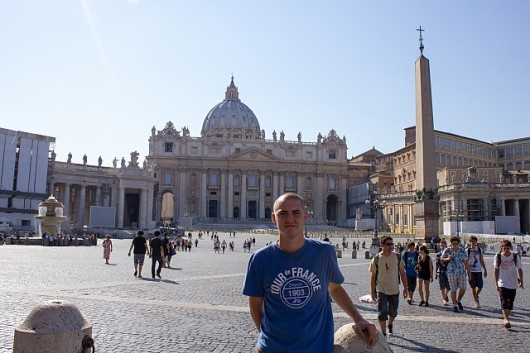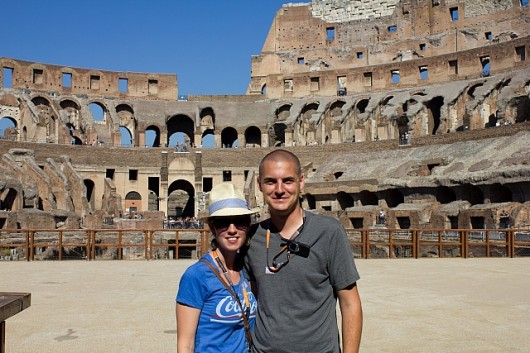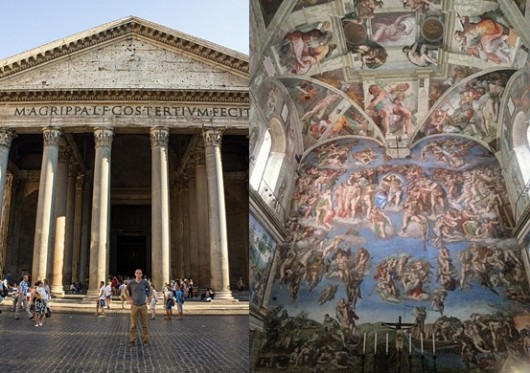The colonnades that surround Saint Peter’s Square outside Saint Peter’s Basilica in Rome are said to have been designed to represent two giant outstretched arms. The arms of the church building (the basilica) thus represent the arms of the Church (the Christian faith). According to the architect, these arms serve a threefold purpose: to strengthen the faith of Christians, to welcome back those who have strayed from the faith, and to enlighten those who are not sure about the faith. Mission accomplished at least as concerns Emily and me. We feel strengthened in our faith after having visited Saint Peter’s and Rome over the weekend, even if all the history and grandeur was very nearly too much to take in during our short stay. For me, I am filled with mixed emotions after touring in the Eternal City. Let me explain.
already but not yet
The faith of Christians in 2012 can be described as already but not yet. The already of our faith is the life, death, resurrection, and ascension of Jesus. The not yet is the eagerness with which we wait for his second coming. We find ourselves between the times, between the already and the not yet. Perhaps this is nowhere more clearly depicted in Rome than in the Sistine Chapel. Above the altar at the front of the chapel, Michelangelo painted an incredible portrayal of the Last Judgment (the not yet). Christ is shown overseeing the resurrection of believers and non-believers alike, the former to life, the latter to torment. The resurrected and reigning Christ is in charge as final judge. The already of the Sistine Chapel is at the foot of the painting: Christ crucified. A large statue of Jesus hanging on the cross sits center stage beneath the last judgment scene. Here the already and the not yet of the Christian faith are clearly contrasted. In one, the savior dies. In the other, the savior reigns. The importance of seeing both together is that the ongoing story of faith is here portrayed. Thinking along these lines, I see the city of Rome itself as presenting the same two contrastive sides of our faith on a much grander scale. In other words, wherever one looks one sees either the already or the not yet of the Christian faith represented. A couple of examples.
the already in Rome
One is quickly introduced to the already of the Christian faith by visiting the main attractions of ancient Rome: the Colosseum, Saint Peter’s, and the catacombs. At each of these sites one learns of the horrific treatment of early Christians. At the Colosseum, Christians were gratuitously killed. Saint Peter’s Basilica, according to tradition, marks the spot where the Apostle Peter was crucified upside down. The catacombs which form a network of 500,000 (1/2 million!) underground Christian graves remind the visitor that during the first several centuries of Christianity Christians were not permitted to be buried in the city itself and held underground church services here instead.The already of Christ’s suffering was replicated in the lives of many early Christians. “If they persecuted me, they will persecute you also” (John 15:20). The already in Rome is sobering.
the not yet in Rome
The not yet in Rome might feel like it should be called the already since the not yet is so well represented in the awe-inspiring grandeur of, for example, Saint Peter’s Basilica. The not yet in Rome, however, can only imperfectly foreshadow the greater not yet of Christ’s return. Are you with me? Wherever ones goes in Rome one finds grand squares with statues, fountains and even Egyptian obelisks (giant pillars which form a pyramid at the top–think Washington Monument). Regal churches (basilicas) line every street. Arches commemorate victories. Any structure remotely impressive was likely envisioned and realized by a famous architect. If then one imagines the not yet of the Christian faith as filled with yet even more grandeur, splendor, and awe-inspiring achievement, the Christian-themed splendor of Rome may be seen to foreshadow it (that is, Christ’s second coming). Am I making some sense? Said another way, seeing the grandeur of Christian-themed Rome, one may find it over-the-top and unbecoming of a religion with humble beginnings. Or, seeing the grandeur of Christian-themed Rome, one may see in it a foreshadowing, an anticipation of the grandeur of Christ’s return. You may think that’s a stretch, but seen this second way, I had a greater appreciation of Rome, avoided touring the city begrudgingly, and put the majesty of the Eternal City into perspective–under Christ. (Even so, one monument I could not stand was Titus’ arch commemorating the destruction of Jerusalem in 70AD. Disgusting.)
the eternal city
Emily and I came away from Rome with our faith strengthened, even if the sight-seeing is a roller-coaster of emotions. Rome is impressive, but Jesus is better. We wait for his eternal city where everything sad becomes undone.








CommentsOnToast